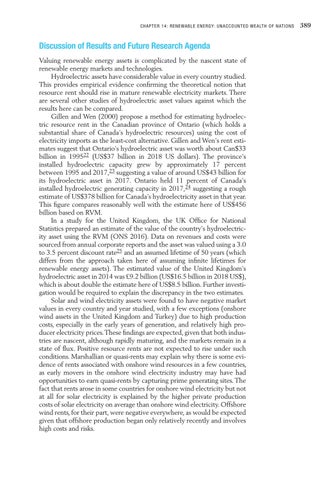C H AP TE R 1 4 : Re ne wab le En e r gy: Unaccou nted Wea lth o f Nation s
Discussion of Results and Future Research Agenda Valuing renewable energy assets is complicated by the nascent state of renewable energy markets and technologies. Hydroelectric assets have considerable value in every country studied. This provides empirical evidence confirming the theoretical notion that resource rent should rise in mature renewable electricity markets. There are several other studies of hydroelectric asset values against which the results here can be compared. Gillen and Wen (2000) propose a method for estimating hydroelectric resource rent in the Canadian province of Ontario (which holds a substantial share of Canada’s hydroelectric resources) using the cost of electricity imports as the least-cost alternative. Gillen and Wen’s rent estimates suggest that Ontario’s hydroelectric asset was worth about Can$33 billion in 199522 (US$37 billion in 2018 US dollars). The province’s installed hydroelectric capacity grew by approximately 17 percent between 1995 and 2017,23 suggesting a value of around US$43 billion for its hydroelectric asset in 2017. Ontario held 11 percent of Canada’s installed hydroelectric generating capacity in 2017,24 suggesting a rough estimate of US$378 billion for Canada’s hydroelectricity asset in that year. This figure compares reasonably well with the estimate here of US$456 billion based on RVM. In a study for the United Kingdom, the UK Office for National Statistics prepared an estimate of the value of the country’s hydroelectricity asset using the RVM (ONS 2016). Data on revenues and costs were sourced from annual corporate reports and the asset was valued using a 3.0 to 3.5 percent discount rate25 and an assumed lifetime of 50 years (which differs from the approach taken here of assuming infinite lifetimes for renewable energy assets). The estimated value of the United Kingdom’s hydroelectric asset in 2014 was £9.2 billion (US$16.5 billion in 2018 US$), which is about double the estimate here of US$8.5 billion. Further investigation would be required to explain the discrepancy in the two estimates. Solar and wind electricity assets were found to have negative market values in every country and year studied, with a few exceptions (onshore wind assets in the United Kingdom and Turkey) due to high production costs, especially in the early years of generation, and relatively high producer electricity prices. These findings are expected, given that both industries are nascent, although rapidly maturing, and the markets remain in a state of flux. Positive resource rents are not expected to rise under such conditions. Marshallian or quasi-rents may explain why there is some evidence of rents associated with onshore wind resources in a few countries, as early movers in the onshore wind electricity industry may have had opportunities to earn quasi-rents by capturing prime generating sites. The fact that rents arose in some countries for onshore wind electricity but not at all for solar electricity is explained by the higher private production costs of solar electricity on average than onshore wind electricity. Offshore wind rents, for their part, were negative everywhere, as would be expected given that offshore production began only relatively recently and involves high costs and risks.
389


